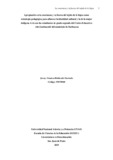Mostrar el registro sencillo del ítem
Apropiación en la enseñanza y la fuerza del tejido de la higra como estrategia pedagógica para afianzar la identidad cultural y la de la mujer indígena Awá con las estudiantes de grado segundo del Centro Educativo Alto Guelmambí del municipio de Barbacoas
| dc.contributor.advisor | Ortega Landazuri, Paulo Emilio | |
| dc.coverage.spatial | cead_-_pasto | spa |
| dc.creator | Bisbicuth Hurtado, Jenny Omaira | |
| dc.date.accessioned | 2019-06-12T16:01:06Z | |
| dc.date.available | 2019-06-12T16:01:06Z | |
| dc.date.created | 2019-05-10 | |
| dc.identifier.uri | https://repository.unad.edu.co/handle/10596/26171 | |
| dc.description | Anexo A. Cuestionario de Entrevista, Anexo B. Matriz de vaciamiento, Anexo C. Plan de aula | spa |
| dc.description.abstract | La comunidad de Alto Guelmambi del Resguardo, Nunalbi Alto Ulbi, municipio de Barbacoas, Departamento de Nariño, sea identificado la falta de las prácticas de tejido de la higra, en diferentes aspectos individuales y sociales, este se centra en la perdida de la identidad y de la cultura de la mujer Awá, la pertenencia del territorio, la sabiduría de la mujer Awá. En vista de lo anterior, se planteó como objeto de estudio, fomentar la enseñanza del tejido de la higra como estrategia pedagógica para afianzar la identidad cultural de la mujer indígena Awá con los niños de grado segundo del Centro Educativo Alto Guelmambí del municipio de Barbacoas, para lo cual se caracterizó los valores, tradiciones, símbolos y creencias en torno al tejido de la higra, así mismo se diseñó y ejecutó la estrategia pedagógica basada en el tejido de la higra enfocada en los diálogos de saberes con las mayores para afianzar la identidad de la mujer Awá, para finalmente interpretar el impacto de la misma. El desarrollo del estudio se fundamentó en el enfoque cualitativo, método investigación acción, en el estudio se contó con una muestra de 70 estudiantes, pero la muestra estuvo representada por los estudiantes de grado segundo de los cuales 8 son niñas y 5 son niños. Las técnicas que se utilizaron fueron: entrevista, diario de campo y grupo focal. Los resultados indican que se logró identificar que en el tejido de la higra se aplican los valores, en primera instancia se fortalece el respeto a la mujer, unido a ello el compromiso, responsabilidad, entre otros, los cuales se aplicaron durante el transcurso que duró la estrategia pedagógica, siendo útil y generando impacto, porque fue un motivante para aplicar en la vida diaria. y conocer a la mujer como el pilar fundamental, siendo la tejedora de conocimientos y saberes que se debe llevar de generación en generación, para conservar el uso y costumbres del Pueblo Awá. donde se desarrolla el tejiendo aprendo. | spa |
| dc.format | spa | |
| dc.format.mimetype | application/pdf | spa |
| dc.language.iso | spa | spa |
| dc.publisher | Universidad Nacional Abierta y a Distancia UNAD | spa |
| dc.title | Apropiación en la enseñanza y la fuerza del tejido de la higra como estrategia pedagógica para afianzar la identidad cultural y la de la mujer indígena Awá con las estudiantes de grado segundo del Centro Educativo Alto Guelmambí del municipio de Barbacoas | spa |
| dc.type | Proyecto aplicado | spa |
| dc.subject.keywords | Tejidos indígenas - Hingra | spa |
| dc.subject.keywords | Artesanías | spa |
| dc.subject.keywords | Estrategias pedagógicas | spa |
| dc.subject.keywords | Identidad cultural | spa |
| dc.subject.keywords | Culturas indigenas - Awa - Colombia | spa |
| dc.description.abstractenglish | The community of Alto Guelmambi del Resguardo, Nunalbi Alto Ulbi, the municipality of Barbacoas, the Department of Nariño, the sea, the lack of practices of school textiles, human rights and social networks, this focuses on the loss of the identity and culture of the Awá Indigenous woman, the belonging of the territory, the wisdom of the Indigenous woman Awá In view of the above, we plan as an object of study, appropriating the teaching of the fabric, as well as the pedagogical strategy, for the cultural identity of the woman, indigenous, with the second grade children, in the Alto Guelmambí Educational Center of the municipality of Barbacoas For what are characterized the values, traditions, symbols and beliefs about the tissue of the fig, so was designed and executed the pedagogical strategy based on the tissue of the fig focused on the dialogues of knowledge with the majors to strengthen the Identity of the Awá Indigenous woman, to finally interpret the impact of it. The development of the study is based on the qualitative approach, the method of action, the study was attended by a sample of 70 students, but the sample was represented by the second grade students of which 8 are girls and 5 are boys. The techniques used were: interview, field diary and focus group. The results indicate that they identify themselves in the fabric of human rights, in the first instance the respect for women is strengthened, it is related to commitment, responsibility, among others, which are applied during the course of time lasted The pedagogical strategy, being useful and generating impact, because it was a motivator to apply in daily life and to know women as the fundamental pillar, being the weaver of knowledge and knowledge that must be carried out from generation to generation, for preserve the use and customs of the Awá people. Where weaving develops I learn. | spa |
| dc.subject.category | Etnoeducación | spa |
| dc.rights.accesRights | info:eu-repo/semantics/openAccess | spa |
| dc.rights.acceso | Abierto (Texto Completo) | spa |















